A kit lens is a "starter" lens which can be sold with an interchangeable-lens camera such as a mirrorless camera or DSLR. It is generally an inexpensive lens priced at the lowest end of the manufacturer's range so as to not add much to a camera kit's price. The kit consists of the camera body, the lens, and various accessories usually necessary to get started. A kit lens can be sold by itself outside of a kit, particularly the ones that are moderately expensive; for instance a kit lens included in a prosumer camera kit is often marketed as an upgrade lens for a consumer camera. In addition, retailers often have promotions of standalone low-end camera bodies without the lens, or a package that bundles a body with one or two more expensive lenses.

The Nikon DX format is an alternative name used by Nikon corporation for APS-C image sensor format being approximately 24x16 mm. Its dimensions are about 2⁄3 those of the 35mm format. The format was created by Nikon for its digital SLR cameras, many of which are equipped with DX-sized sensors. DX format is very similar in size to sensors from Pentax, Sony and other camera manufacturers. All are referred to as APS-C, including the Canon cameras with a slightly smaller sensor.

The Pentax K10D and similar Samsung GX-10 are 10.2-megapixel digital single-lens reflex cameras launched in late 2006. They were developed in a collaboration between Pentax of Japan and Samsung of South Korea.

The Nikon D40 is a 6.1-megapixel DX format DSLR Nikon F-mount camera announced by Nikon on November 16, 2006. It replaces the D50 as Nikon's entry level DSLR. It features a 2.5-inch 230,000-dot resolution LCD monitor, CCD sensor with ISO 200-1600 and 3D Color Matrix Metering.

The Nikon D60 is a 10.2-megapixel Nikon F-mount digital single-lens reflex camera announced in January 2008. The D60 succeeds the entry-level Nikon D40x. It features the Nikon EXPEED image processor introduced in the higher-end Nikon D3 and D300.

The Nikon D700 is a professional-grade full-frame digital single-lens reflex camera introduced by the Nikon Corporation in July 2008 and manufactured in Japan. It uses the same 12.1-megapixel "FX" CMOS image sensor as the Nikon D3, and is Nikon's second full-frame digital SLR camera.

The Nikon D90 is a 12.3 megapixel digital single-lens reflex camera (DSLR) model announced by Nikon on August 27, 2008. It is a prosumer model that replaces the Nikon D80, fitting between the company's entry-level and professional DSLR models. It has a Nikon DX format crop sensor.

The Nikon D3S is a 12.1-megapixel professional-grade full frame (35mm) digital single-lens reflex camera (DSLR) announced by Nikon Corporation on 14 October 2009. The D3S is the fourth camera in Nikon's line to feature a full-frame sensor, following the D3, D700 and D3X. It is also Nikon's first full-frame camera to feature HD (720p/30) video recording. While it retains the same number of pixels as its predecessor, the imaging sensor has been completely redesigned. Nikon claims improved ultra-high image sensor sensitivity with up to ISO 102400, HD movie capability for extremely low-lit situations, image sensor cleaning, optimized workflow speed, improved autofocus and metering, enhanced built-in RAW processor, quiet shutter-release mode, up to 4,200 frames per battery charge and other changes compared with the D3. It was replaced by the D4 as Nikon's high speed flagship DSLR.

The 18-55mm f/3.5-5.6G AF-S Zoom-Nikkor lens is a midrange zoom lens manufactured by Nikon for use on Nikon DX format digital SLR cameras. Often included as a kit lens on entry-level DSLRs, it also can be purchased separately from the camera body. Nikon first introduced the lens in 2005 and has provided three subsequent updates. Following are the four variants as of 2014:
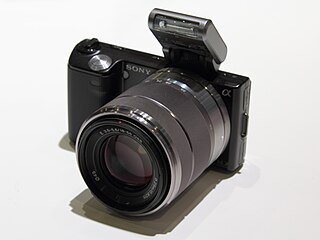
The Sony α NEX-5 is a digital camera launched on 11 May 2010. It is a mirrorless interchangeable lens camera with the body size of a larger model fairly compact point-and-shoot camera with a larger sensor size (APS-C) comparable to that of some digital single-lens reflex cameras. Its major competitors in the market are the cameras based on the micro 4/3 standard created by Panasonic and Olympus, and a few low end Canon, Nikon, and even Sony α DSLRs. The NEX-5 shoots 14.2 megapixel stills and has a 7 frame/s continuous shotmode. It has the capability to shoot 1920×1080i at 60 frame/s in AVCHD or 1440×1080p at 30 frame/s in MPEG4. The NEX-5 was replaced by the 16 megapixel NEX-5N in August 2011.

The Nikon D3100 is a 14.2-megapixel DX format DSLR Nikon F-mount camera announced by Nikon on August 19, 2010. It replaced the D3000 as Nikon's entry level DSLR. It introduced Nikon's new EXPEED 2 image processor and was the first Nikon DSLR featuring full high-definition video recording with full-time autofocus and H.264 compression, instead of Motion JPEG compression. It was also the first Nikon DSLR to provide high-definition video recording at more than one frame rate.

The Nikon 1 series is a discontinued camera line from Nikon, originally announced on 21 September 2011. The cameras utilized Nikon 1-mount lenses, and featured 1" CX format sensors.
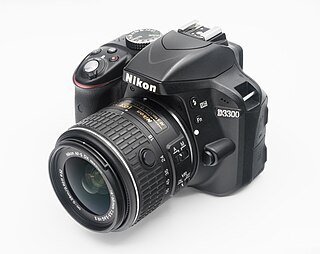
Nikon D3300 is a 24.2-megapixel DX format DSLR Nikon F-mount camera officially launched by Nikon on 7 January 2014. It was marketed as an entry-level DSLR camera for beginners and experienced DSLR hobbyist who were ready for more advanced specs and performance. It replaced the D3200 as Nikon's entry level DSLR. The D3300 usually came with an 18-55mm VR II kit lens, which is the upgraded model of older VR lens. The new kit lens has the ability to retract its barrel, shortening it for easy storage.
The 18-300mm f/3.5-6.3G lens is a telephoto superzoom lens manufactured by Nikon for its line of DX DSLR cameras.
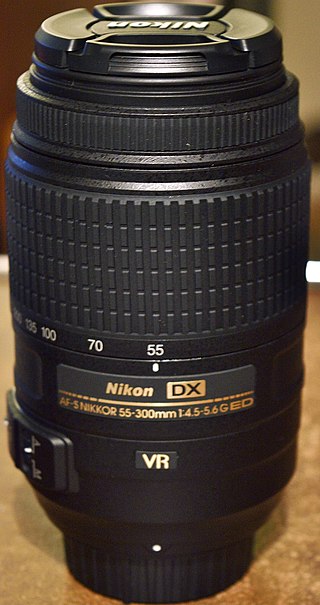
The 55-300mm f/4.5-5.6G AF-S lens is a telephoto superzoom lens manufactured by Nikon for its line of DX DSLR cameras.
The 18-300mm f/3.5-5.6G ED VR is a telephoto superzoom lens manufactured by Nikon for its line of DX DSLR cameras.
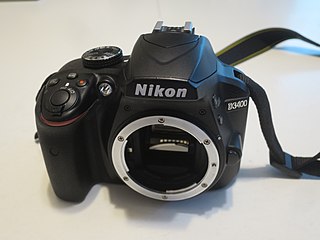
The Nikon D3400 is a 24.2-megapixel DX format DSLR Nikon F-mount camera officially launched by Nikon on August 17, 2016. It is marketed as an entry-level DSLR camera for beginners and experienced DSLR hobbyists. It replaces the D3300 as Nikon's entry level DSLR.

The Nikon D5600 is a 24.2 megapixel upper-entry level, APS-C sensor DSLR announced by Nikon on November 10, 2016, as the successor of the D5500. The camera has an F-mount.
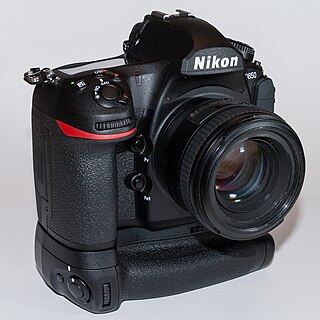
The Nikon D850 is a professional-grade full-frame digital single-lens reflex camera (DSLR) produced by Nikon. The camera was officially announced on July 25, 2017, launched on August 24, 2017, and first shipped on September 8, 2017. Nikon announced it could not fill the preorders on August 28, 2017 and filled less than 10% of preorders on the first shipping day. It is the successor to the Nikon D810.
















